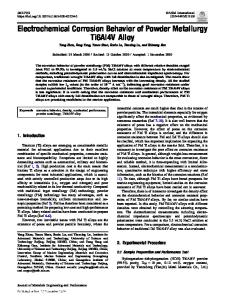Mechanical Behavior of Titanium-Based Layered Structures Fabricated Using Blended Elemental Powder Metallurgy
- PDF / 8,365,361 Bytes
- 21 Pages / 593.972 x 792 pts Page_size
- 35 Downloads / 364 Views
JMEPEG https://doi.org/10.1007/s11665-019-04263-0
Mechanical Behavior of Titanium-Based Layered Structures Fabricated Using Blended Elemental Powder Metallurgy Pavlo E. Markovsky, Dmytro G. Savvakin, Orest M. Ivasishin, Vadim I. Bondarchuk, and Sergey V. Prikhodko (Submitted November 28, 2018; in revised form May 30, 2019) Mechanical behavior of bilayered structures composed of the layer of Ti-6Al-4 V (wt.%) (Ti-64) alloy and metal matrix composite (MMC) on the base of this alloy reinforced with 5 and 10% (vol.) of either TiB or TiC particles has been studied. Structures were fabricated using blended elemental powder metallurgy and studied by tensile and three-point flexural tests. Mechanical tests were performed on uniform single-layer samples of the alloy as well as individual MMCs. In addition, bilayered structures were also tested in threepoint flexural experiment. Posttest fractographic inspections were made using the SEM. The deformation energy was measured based on engineering stress–strain curves obtained on tensile test. The results were compared with the data previously reported on Ti-64 alloy fabricated using cast and wrought technique. The presence of TiB and TiC reinforcement particles in the alloy causes substantial drop in strength and ductility of MMCs as compared to uniform sintered Ti-64 alloy, since those particles provide additional sites for the cracks and pores nucleation and promote the embrittlement of material. However, when MMC layers are used in bilayered structures with Ti-64 alloy layers, the three-point flexural test demonstrates significant increase in flexure stress compared to uniform Ti-64 alloy and uniform structures of MMCs. The suitability of studied structures for antiballistic impact application is discussed. Keywords
deformation energy, deformation rate, layered structures, mechanical properties, metal matrix composite, three-point flexural test, titanium
1. Introduction High specific strength, corrosion resistance and biocompatibility of Ti-based alloys make them well-established and highly demanded materials in aerospace, automotive, medical and other applications (Ref 1-4). Reinforcement of Ti-alloys with hard and light particles of TiC and TiB is a credible pathway to make metal matrix composite (MMC) with enhanced elastic moduli of materials without compromising their low weight (Ref 5-7). However, reinforcement of the alloy with hard particles generally lowers the value of toughness and plasticity of material. Nevertheless, in many applications simultaneous high hardness and high plasticity are not required (or can be compromised) through the entire structure. For instance, parts that require enhanced wear resistance or resistance upon ballistic impact demand high hardness and strength at the surface, whereas their core necessitates rather high toughness and ductility (Ref 8). Such combination of mechanical properties can be achieved on parts made of layered structures joining two and more layers of different materials with different chemical compositions and/or Pavlo E. Ma
Data Loading...











